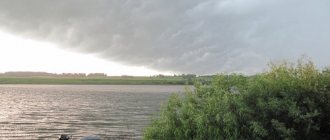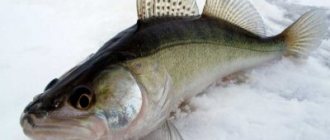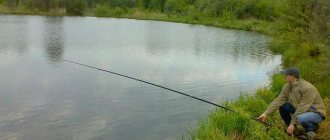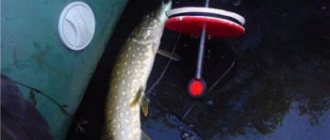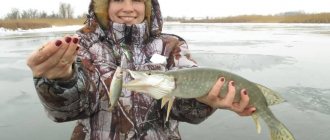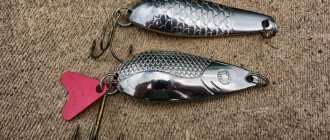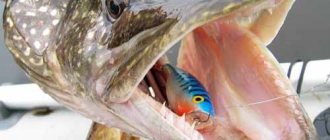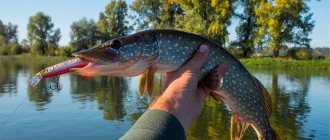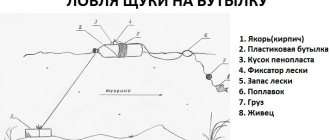Hunting for a toothy predator is characterized by incredible excitement, a sense of adrenaline and requires from the fisherman not only dexterity, but also intelligence. This is a worthy and strong opponent for a true fishing connoisseur.
In order for this event to be a success, and for the desired trophy to end up in the cage, you will need to become more thoroughly familiar with the predator’s habitats, study its habits and select the right equipment.
Pike: description and behavioral characteristics
Pike belongs to the category of predatory fish. Thanks to its elongated cylindrical body, the predator is able to attack its prey with lightning speed. A powerful, muscular tail allows the fish to make strong jerks from a standing position to attack smaller fish. And the dorsal and anal fins, located in the back of the fish’s body, give it the ability to both accelerate and maneuver in the water.
The color of a predator’s scales is determined by its habitat; most often there are individuals with a brown-green tint of scales and a silver belly.
A distinctive feature of the predator is its strong and huge mouth, in which there are numerous thin and sharp teeth curved inward. The palate and gills of pike also have small and dangerous teeth. Her victim has virtually no chance of breaking free.
The maximum possible size of the predator is 1.5 m, and the weight is from 30 to 35 kg, but this is possible when the fish is 30 years old. Usually in reservoirs you can find pike with a length of 1 m and a weight of up to 8 kg.
The fish prefers to set up ambushes in thickets of aquatic vegetation, snags, and reeds.
Features of pike behavior:
- An increased sense of caution, which complicates the hunting process. The fisherman must be extremely careful and patient, not create unnecessary noise, that is, strictly follow the rules of camouflage.
- Moves through a body of water in jerks, against the current. Depending on the size of the fish, in one such time it can overcome from 2 to 4 m.
- It has hypersensitivity, from light touches to its body, the fish jumps out of the water (at an instinctive level), the trajectory of its movement changes.
- Since childhood, the toothy predator loves to live alone; in a small body of water, one individual reigns.
- When playing for such a coveted trophy, it is recommended to avoid its razor-sharp teeth.
Bite at different times of the year
in spring
At the beginning of spring, even before the ice has melted everywhere, this predator emerges from the depths and moves to the outskirts of the ice, gullies, river mouths and begins to hunt intensively.
This predator begins to eat. Pike at this time are truly the most active of all seasons. During this period, pike are caught with completely different baits: wobblers, foam rubber, spinners, live bait, etc. Moreover, it is worth noting that large individuals are active at this time, so the chance of catching them is really high. As soon as the ice melts completely, fishermen go fishing with spinning rods. It is convenient to catch a predator before the water level begins to rise. Pike usually like to be near the thickets at this time.
However, it is worth remembering that in many regions, fishing for pike during spawning is prohibited. Therefore, before fishing, you should clarify whether it is possible to catch pike at this time or should you wait.
In summer
Some fishermen believe that it is almost impossible to catch pike in the summer. But this is far from true, because even in the hottest time this predator continues to feed, and if it feeds, then it can be caught. In the summer, this predator prefers to be in the shade of thickets, trees, in pits - where it is cooler. Most often she goes hunting in the evening or early in the morning. Taking this into account, you can find and catch this predator.
in autumn
Just like spring, autumn is also a good time to catch a predator. And this is not surprising, because the heat itself has subsided, and the pike needs to eat up before wintering, so it begins to hunt intensively. Thus, she begins to eat, which, unlike spring and summer, is longer and more stable. Pike bite most actively in the morning. If you look at the calendar, all this is due to the cooling of the water, which begins in September and continues until November. The most successful fishing will be in October, not at great depths, but somewhere at 1-1.5 m.
Pike fishing in winter
With the arrival of cold weather, pike does not go into suspended animation, like other fish species, so even in the dead of winter it can grab the bait that happens to be near its camp.
But it is worth noting that the activity of the predator is significantly reduced. And this is easy to notice by the nature of her bites, because there are days when she doesn’t bite at all. Pike do not gather in schools in winter, but they are quite close to each other, because... Their feeding areas are reduced; they can usually be found along the underwater edges. December
At this time, pike are even more active and are excellently caught from under the ice. The most suitable baits are balancers and spoons. Where the ice has not yet frozen, the predator can be caught using jig baits.
January
January is a period of low winter. At this time, this predator is well caught on girders. There is not much bite on the spinner and the balancer. The most suitable bait for fishing is live bait. Important: in many regions of the Russian Federation there is a strict limit on the number of fishing poles per 1 fisherman, so before fishing, check whether it is allowed to fish this way in a given region and how many fishing poles can be used.
February
At this time, the pike becomes active again and is again perfectly caught on balance beams and spoons. However, an important point should be noted that it does not particularly bite on “bare” iron; it is necessary to attach an animal bait, for example, a worm. The pike begins to move intensively around the reservoir and move around, so if there is no bite in one place for a quarter of an hour, then you need to change fishing spots.
Habitats
For a toothy predator, where it lives is not of fundamental importance; it thrives equally well in salt water, in marshy swamps, and in water areas with sulfurous water.
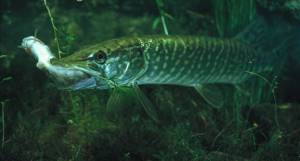
The main period of life, pike leads a sedentary lifestyle, with the exception of the spawning period (it heads up the river) and winter (it goes into the pits).
Small-sized reservoirs for this predator with the arrival of winter can cause its death. Even deep rivers and lakes without springs and ice holes cannot provide fish with comfortable living conditions, since the vegetation rots and the amount of oxygen is sharply reduced. And without air, aquatic inhabitants suffocate.
Medium specimens adhere to the coastline, where there are small and grassy areas, but for large specimens it is preferable to be in the depths. The young generation of pike gathers in places overgrown with reeds and grass. There the fish find shelter, hiding in moss, driftwood, and bushes.
in winter
How to fish for pike in summer
The hard water season is difficult for pike fishing enthusiasts, since most of the winter the fish are in a passive state and it is quite difficult to catch them. The optimal time intervals for catching pike in winter are considered to be the periods immediately after freeze-up, as well as the time shortly before the melting of the ice cover - the so-called first and last ice. It is at this time that the toothy predator becomes most active and bites best.
However, at this time, the fisherman is required to exercise maximum caution, since the ice cover on reservoirs at this time is thinnest, which is why there is a fairly high probability of falling through the ice, which can end in tragedy. For this reason, safety precautions should never be neglected when ice fishing.
During the so-called dead winter period, pike, as a rule, stand in deep holes and practically do not hunt. Searching for it at this time is quite difficult; you have to drill a large number of holes. A slight increase in the bite can be observed at the end of winter on warm sunny days, when the ice begins to thaw - in such weather the pike becomes more active and begins to move more around the reservoir in search of food.
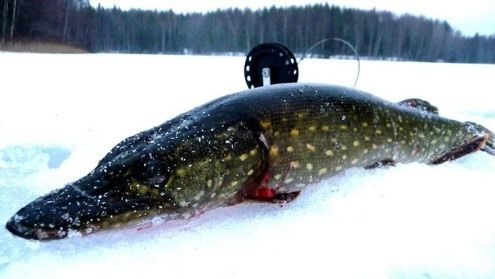
During the dead of winter, many anglers switch to fishing on girders, since in this way they can fish a fairly large number of promising points at the same time. In addition, the big advantage of such fishing is that the girders can stay on the ice much longer than the fisherman himself, who is affected by the cold.
Biting calendar by fishing season
Spring
In the spring season, there is increased fish activity, but for each month the effectiveness of bites is different:
- March is considered an ideal month for pike hunting; the fish are so hungry that they rush at bait indiscriminately (spinners, live bait, twisters, wobblers, cicadas, etc.), ignoring the rules of caution.
- April is associated with muddy water in the reservoir, as the period of river flooding begins. At this time, it is advisable to use baits with a noise effect: petal jigs, noise wobblers with an interesting game, etc.
- May is characterized by rising air temperatures and warming water; small fish begin to grow, which especially attracts predators. Good results are obtained by using wobblers with active play and rotating spoons.
Summer
Although the weather is too hot, hunting is still possible:
- June. At the beginning and until the middle of the month, stability of pike bites is observed, then the intensity of the bite gradually decreases. The fishing object tries to hide from the sultry heat in algae or go deeper. The optimal bait for fishing this month is an oscillating spoon with a size of 5–7 cm.
- July. The heat peaks, and the amount of algae increases sharply. At normal temperatures, the predator continues to actively feed, but when it rises, the bites subside and are practically non-existent. You can experiment with large-sized baits.
- August. The water in the reservoir gradually begins to cool, which has a beneficial effect on the capture of the coveted trophy. The fishing efficiency is high; they hunt for any gear, both in size and type.
Autumn
The period of maximum activity of the trophy is characterized by the stability and intensity of bites:
- September. There is a high probability of catching trophy specimens of this predatory category of fish. For hunting from the shore near aquatic vegetation, small spoons and wobblers work great. If you use a swimming device for fishing, it is better to use jig baits.
- October is a favorable month for fishing with a spinning rod; the fished object responds perfectly to everything that sparkles. The optimal size of the bait is 10–12 cm; for example, wobblers, all kinds of spinners, and spinners are used.
- November is a good month for catching large specimens, especially in the early morning. It is effective to hunt for vibrating tails, balancers, with the exception of silver-colored ones, and oscillating spoons.
Winter
With the arrival of severe frosts, the predator does not fall into winter torpor. Biting is possible:
- December. For hunting on the first ice, it is recommended to use various balancers, spoons and baits. For those regions where the water is not yet frozen, you can use jig baits.
- January. Fishing during this month is ineffective, there is practically no bite. The fish are somewhat passive, but bites are likely. Girders can be used as catching gear.
- February. This month, the individual begins to become more active; it is attracted to blanks, spoons in combination with a worm or pieces of fish.
The best lures for pike in spring
Fishermen know pike as a greedy fish that does not particularly care about its safety and is caught by a large number of baits (especially in the spring, before spawning). Sometimes she is ready to grab an almost empty hook.
What to fish with
However, it is better to use high-quality bait when hunting for pike. Among those that bring results to fishermen from year to year, it is worth noting:
- Oscillating spinner. One of the most favorite types of bait among experienced fishermen. A spoon can attract pike with just one leisurely movement that fascinates the fish. It is best to cast the bait a few meters from the probable location of the predator.
- Fishing with live bait. For such bait, it is best to choose medium-sized fish such as small perch or roach. The freshness of the bait is important; it is best if it is still quite active. In this case, you have a better chance of attracting the pike's attention.
- Wobblers. An excellent type of bait. It is popularly called the “pike killer,” which already says a lot. Among them there are both surface models and deep-sea ones.
- Jig baits. Twisters and vibrotails come in a variety of shapes and sizes, but in the spring it is best to use silicone baits at least 5-7 cm in size.
- Poppers. It is best to catch pike with this bait in May, when there is already the first vegetation on the surface of the water.
About
Factors influencing pike biting
- Moon phases. Based on numerous observations by experienced fishermen, active pike biting can be observed on the 1st-7th, 17th-21st days of the new month.
- Weather. Fish, by their nature, are quite sensitive to magnetic storms; they feel them within 2-3 days, unlike humans. It is before the onset of such a phenomenon that aquatic inhabitants try to feed well so as not to feel hungry during such days. The intensity of the bite increases with a sharp jump in temperature, followed by a prolonged cold snap and rapid warming.
- Daily mobility. Favorable time for hunting a toothy predator:
- early in the morning 1.5-2 hours before sunrise;
- from 15.00 to sunset;
- At night, this fishing object is quite active.
What does the bite depend on?
The bite of a predator, like the bite of many species of fish, is influenced by a number of factors:
- Lunar phase . Fishermen have long noted that if the moon is in any phase, this affects the activity of the fish. And this predator is far from an exception. It is possible to distinguish 2 peaks of the greatest activity of pike: from 1 to 7 lunar days and from 17 to 21. Fishermen also note that the influence of the phases of the moon primarily affects individuals that live in closed reservoirs, for example, a pond, and predators, those living in large bodies of water are less dependent on it. However, you should not take this as an unshakable rule, because... In addition to the phases of the moon, a number of other factors influence the activity of fish.
- Weather . The most suitable weather for catching this predator is cloudy days when a light breeze blows. If there is a little rain, this will also have a good effect on the bite. A decrease in atmospheric pressure or its stability is also observed in the pike bite. For example, before a thunderstorm there is a high biting intensity. In winter, a sharp drop in temperature negatively affects the bite of this predator. And if, on the contrary, the weather is stable, even if it’s minus 20 outside, you can safely go fishing. During the thaw, the pike's bite improves significantly.
- Daily activity . Sometimes pike bites are even throughout the day, but usually pike are caught at the most active time, when the pike goes hunting. The number of exits per day can be large, or it can be 1 - it’s quite difficult to guess, they last 15-20 minutes. Under the most suitable conditions for fishing, active pike bites begin 2-3 hours before dawn and periodically repeat 2-3 hours before noon. And then the second peak begins in the afternoon and ends at night.
Optimal conditions for pike biting
Considering the strong dependence of pike on various factors, it is recommended to adhere to the following recommendations so that the treasured trophy ends up in the cage:
- Time factor. The most productive time for hunting is considered to be before sunrise (1.5 hours) and after 15.00 hours before sunset.
- Weather. The predator prefers to feed in cloudy weather, not much rain, and light wind.
- Atmosphere pressure. The best biting period is observed at low atmospheric pressure.
- Temperature regime. Very high or too low temperatures prevent fishing. In the spring-autumn season, it is better to hunt when the water temperature in the reservoir is from 8 to 25 degrees Celsius, and in winter the air temperature should not exceed 15 degrees below zero.
- Fishing place. If hunting is intended for representatives of the predatory category of fish of medium and small sizes, it is advisable to fish snags and overgrown with reeds or algae places near the coastal zone. Particular attention should be paid to areas near rifts and dams. To catch large individuals, it is recommended to choose deep-water areas of the reservoir. You should know that such a predator avoids silty, shallow rivers and lakes, since they contain a small amount of oxygen.
Pike fishing in the morning: what is the probability of a bite?
Pike are more active in the morning than usual. Early morning, before sunrise, is an excellent time to hunt a hungry predator.
You should look for pike at dawn in shallow water, where it will be in ambush for its prey.
Morning fishing for predators involves the use of large baits. It will be good if the chosen attachment is distinguished by active play. At this time, pike poorly distinguish artificial baits from live fish, so it is in the morning that it is possible to catch real large specimens.
Pike fishing methods
Pike is such a unique fishing object that almost all types of gear are suitable for catching it.
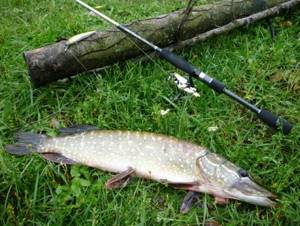
Among which:
- Spinning. It is equipped with spinners, silicone baits, various wobblers, rigs with small fish, poppers, walkers, jerks, and trolling baits. Spinning can easily be called a universal fishing tool for hunting cunning predators. With its help, you can easily examine all layers of a reservoir, starting from the surface to the very bottom; you can come across individuals weighing from 0.5 kg to 30 kg.
- Fly fishing. This method of fishing is especially relevant for true connoisseurs of fly fishing. You can catch the desired specimen using streamers in ponds with dense vegetation or in flooded irrigation areas.
- Float tackle. Fishing with a float rod using live bait is very effective. For fishing in bodies of water without a current, it is recommended to use a balloon as a float.
- Bottom tackle. Hunting is carried out using all kinds of animal bait, in particular live bait and frogs. The classic method of fishing with a donk: the bait is cast at night and checked at dawn. Catching a worthy specimen using bottom tackle is a great achievement for the fisherman.
- Feeder gear using live bait or small fish gives good results when catching predators in bodies of water with strong currents.
- Mugs. The whole process is carried out from a floating craft, using live bait as a suitable bait.
- Zherlitsy. This method of fishing is used not only in summer (the tackle is attached to bushes on the shore of a reservoir or to snags), but also in winter (the tackle is placed in holes).
- Sheer glitter. Here you can use all kinds of vertical baits, from balancers to jigs. This method can be used both in winter from ice and in summer from a boat. Sheer trolling is a bright, emotional activity where the catch is not only qualitative, but also quantitative.
When to catch pike
Pike are active throughout the daylight hours; in the summer, the bite weakens by lunchtime, but resumes again in the evening.
and the excitement of the reservoir, the pike continues to bite at lunchtime. However, the best time of day for pike fishing is considered to be morning dawn. At this time, the pike's appetite increases sharply. The first meal of pike begins after the ice melts from the reservoirs. The second is a week after the end of spawning. During this period, the pike tries to fill its stomach to the limit, so that it can then rest and not eat for several days. The third zhor occurs in September-October, when pike fatten in preparation for winter.
Fishing for pike with a spinning rod from the shore can be especially successful in October, when the pike is almost at its peak of feeding. At this time, pike prefer larger baits, which they grab almost indiscriminately.
Source: rybkolov.ru
The best lures and baits
The most catchy lures and baits for pike include:
- Live bait. A live fish always remains the most desirable prey for a predator, and the effect of such fishing is simply incredible. This bait, unlike artificial fish, is characterized by unpredictable play; the movements of the live bait provoke the predator to instantly attack.
- Oscillating spinners . The spoons fully meet all the physiological needs of pike. To catch large specimens, experienced anglers prefer the Eppinger Daredevle Spoon; it works great in clean and deep waters, regardless of the fishing season.
- Rotating spinners. Pinwheels are great for catching active fish. Among the huge variety of spinners, the Blue Fox Super Bou, Mepps H210 and Mepps Double Blade Aglia products have proven themselves well. Particularly good catches with such baits are possible during the period of maximum fish activity. Rotators work equally well both in shallow water and in deep water.
- Spinnerbaits. This product gives good results both during the period of fish passivity and when it is highly active. Due to the design features of the bait, the predator reacts with lightning speed.
- Wobblers. Here it is possible to use both a floating and sinking type of bait, and a suspender. Wobblers in the Minnow shape are distinguished by their catchability. If the expected size of the prey is not too large, then baits with a length of up to 8 cm are suitable; for catching larger individuals, it is recommended to use products with a length of up to 13 cm. Wobblers can interest a passive predator.
- Vibrating tails, twisters. Due to their small size, baits of this variety are perfect for catching specimens from great depths. Vibrating tails and twisters are most relevant during the spring and autumn hunting seasons.
Folk signs of pike biting
You can catch the moment of a pike's zhor by focusing on folk signs. The fact that the water in the river has risen and warmed up is recognized by the flowering of bird cherry and rose hips. Dandelions appeared in the meadows, the oak tree was covered with its first leaves, and quails began to sing. The post-spawning period of pike biting coincides with high water. Where the pike has spawned, it will feed.
The richest catch can be obtained in autumn and spring after spawning. Morning and evening are the best times to hunt pike during the day. But experienced and skillful fishermen do not deny themselves the pleasure of fighting with river predators at any time of the year and successfully catch large specimens regardless of the season.
Views: 922
Similar articles:
- What time of day to catch pike in the summer Pike can be caught at almost any time of the day and...
- In what weather is it better to catch pike: atmospheric pressure, wind strength and direction, biting in the rain. Under what weather conditions does pike biting increase, what causes it...
- Pike spawning. When, where and under what conditions does pike spawn? Pike spawning is an amazing phenomenon in which these fish...
- Pike fishing in March: where to look and what to catch March fishing, depending on the vagaries of nature, may fall on…
Reasons for lack of biting
Pike can be so picky that it will not be interested in either a bright wobbler or the fattest live bait.
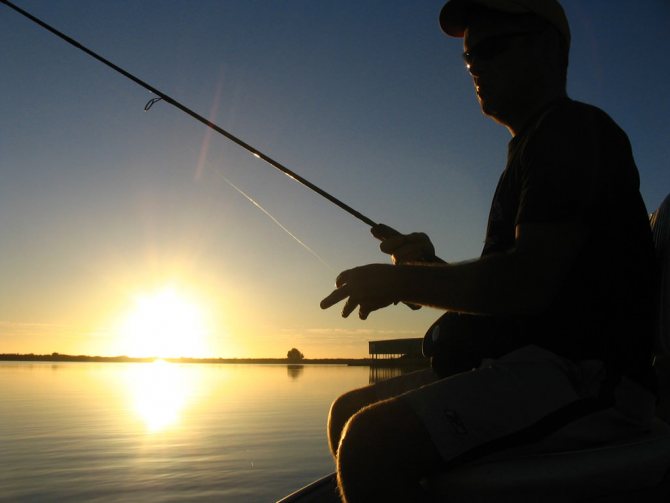
Among the reasons for this behavior are:
- It's not a good time to go fishing. In winter, when the fish is in a secluded place, or in the spring after the spawning period, when the fish is weakened, you should not count on a good catch. In the summer heat, especially at 40 degrees, the predator sinks to depth or takes refuge in algae.
- Fishing place. Considering that pike prefers to build ambushes in the hottest places, hunting it in open water is ineffective. Even if fishing is carried out in suitable places, but there is no bite, most likely there is no one here.
- Choice of bait. If the fish are not attracted to either the vibrotail, the twister, or the spinner, then it is recommended to change the type of bait.
Spring pike fishing with spinning rod. Peculiarities
When catching predators in the spring, you need to take into account certain points, which cannot be said about summer or autumn fishing.
- It is best to fish in shallow water - the fish prefers to live in places with standing water, where the depth does not exceed 1.5 meters.
- It is recommended to use small-sized baits whose retrieve speed is low. The predator at this time is still weak after spawning and will not go after large prey, which, in addition, also moves quickly.
- In some regions there is a spawning ban on catching pike in the spring.
Fishing for pike in early spring with a spinning rod
As mentioned above, in early spring in some regions it is prohibited to catch pike by any means (including spinning). In addition, if the harsh winter is behind us, there is still ice in many bodies of water. So you should postpone your fishing trip.
If there is no spawning ban, and all the ice has disappeared, then it is better to hunt pike in small rivers and creeks, as well as at the mouths of streams that flow into lakes.
In March, there is very changeable air pressure and temperature, so it is unknown when a great bite will overtake you - in sunny or cloudy weather. The best time to fish this month is morning and evening.
During the pre-spawning period, pike attacks any bait, even the most primitive ones. Therefore, spinners have a chance of a good catch.
Pike on a spinning rod in April
In April, pike usually bite poorly and are caught using spinning rods. The fish is either in the process of spawning, or has just finished it, and therefore is “sick.” In addition, April is characterized by floods, when pike stand in the coastal zone, among the reeds.
If during this period the predator goes out hunting, it is only in shallow water, where it can profit from small fish. There is no point in looking for it at depth at this time.
Another disadvantage of catching a predator using a spinning rod in April is that the fish begins to sort through the bait. She will no longer throw herself at anything. Simply put, April is considered far from the best month for catching pike with a spinning rod - you will only waste your time and effort.
About
Fishing technique and tactics
You can arouse the predator’s interest using one of the proposed wiring options:
- Uniform wiring is more suitable for hunting using spinners, spinners, twisters, vibrating tails, and wobblers. If there are no bites, it is recommended to switch to slow retrieve.
- Stepped fishing is used when fishing with jig baits, oscillating spoons, and front-loaded spinners.
- The twitching technique is relevant when catching predators using poppers, spinnerbaits and various wobblers. All the work of attracting fish falls on the tip of the rod; it is held at the surface of the water. The fisherman makes short twitches with the rod, which allows him to compensate for the resulting slack in the fishing thread.
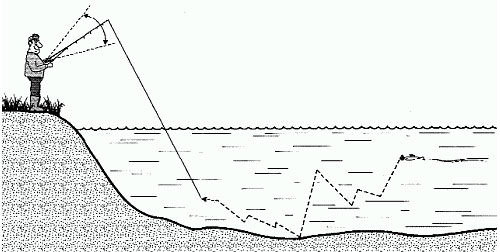
Stepped wiring
What is the best weather for pike fishing by season?
When determining the best weather parameters for pike, they take seriously adjustments for the season of the year. From general observations, we can identify a number of factors that determine the intensity of the bite, which depend little on the time of year. These include sudden changes in temperature, whether it is an increase or decrease . Abnormal summer heat and severe winter frosts, setting in for five to seven days, reduce the bite to nothing, absolutely not taking other weather phenomena into account.
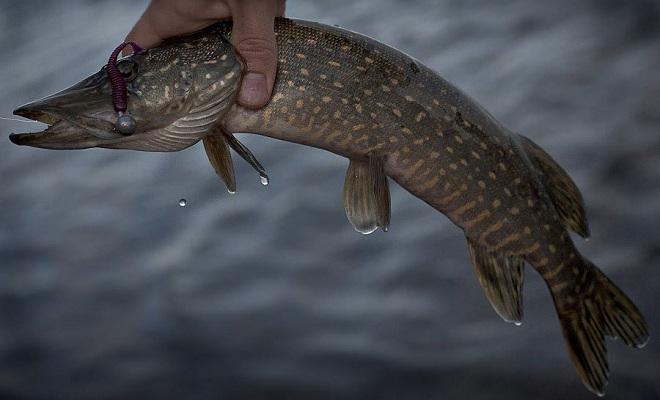
It is also worth focusing on the fact that pike bite better in cool water. An increase in water temperature in the warm season above 22 degrees forces the predator to retreat to depths and reduce feeding intensity. The next part of the article will be devoted to an analysis of optimal weather conditions for a specific season of the year.
Optimal conditions for catching pike in autumn
Pike weather in autumn does not tolerate radical changes. The gradual and natural cooling of the season stimulates the fish to prepare for the hungry winter period and in October brings the predator to the autumn glutton that begins at this time. Now warming temperatures can negatively affect the nutrition of fish, which is especially noticeable with the advent of Indian summer. The onset of frost with the loss of aquatic vegetation, on the contrary, favors successful fishing. The air temperature for pike fishing in autumn is ideal. Water at 5–10 degrees is most saturated with oxygen and the predator is at its peak of annual activity.
Important! Drizzling rains for several days with a moderate wind, which is also accompanied by constant cloudy weather, contribute to the bite.
Under such conditions, pike move throughout the entire reservoir without staying in permanent places. It’s easier to catch it in motion, and the list of preferred baits in the fall is unlimited; absolutely everything is included, from live bait to large, faded-colored spinners.
What weather to fish for pike in winter
Freeze-up initially greatly activates the predator, because every angler knows first-hand the success of fishing in first-ice conditions, especially during periods of stable pressure without surges. Over time, the fish, crushed by the thick ice, lose activity, switching to episodic bursts of biting, which are clearly recorded on sunny days during thaws, without regard to the deep winter. But even on such days the wind should be from the south and south-west, and with a change the bite immediately worsens.

Important! Heavy snowfalls do not promise successful fishing, and the release of water onto the ice has a particularly negative effect on the bite.
As the spring months approach, the number of sunny days with prolonged thaws becomes greater, and therefore the likelihood of a good bite increases.
Pike weather in spring
With the spring melting of the ice, the predator begins to prepare for spawning, increasing its depleted energy reserves after wintering. Fish react to warming water and its oxygen saturation by moving to smaller areas of reservoirs. Unlike autumn, in spring sunny days are more promising for hunting, as well as days with partly cloudy skies and light drizzle with moderate winds. A change in temperature from frost to heat is not as critical for the feeding activity of a growing predator as a sharp decrease or increase in atmospheric pressure, which worsens the bite. When spawning begins, the pike completely stops feeding, resuming it only after spawning and then in a lower mode than before spawning. Closer to summer, it becomes more successful to catch toothy fish on cloudy days with the orientation of a warm southern wind.
Pike weather in summer
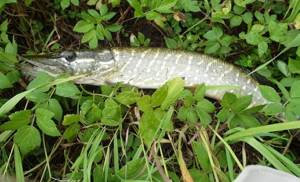
Summer toothfishing is more promising in partly cloudy weather. On such a day, fish hatches occur when the intensity of sunlight decreases, as well as at dawn and dawn. In the heat, the fish stop feeding, going into the depths with colder water. Pike loves periods with light drizzling rain, and especially pre-storm times, when within a couple of hours before bad weather its feeding activity rises to the level of gluttony. After serious bad weather, you can forget about bites for a day or two until the weather conditions completely stabilize. After the heat subsides, the predator becomes more active and, in cloudy weather, will be caught all day, and a moderate wind will only contribute to the bite, reliably camouflaging the fisherman and making the predator more relaxed in its actions.
